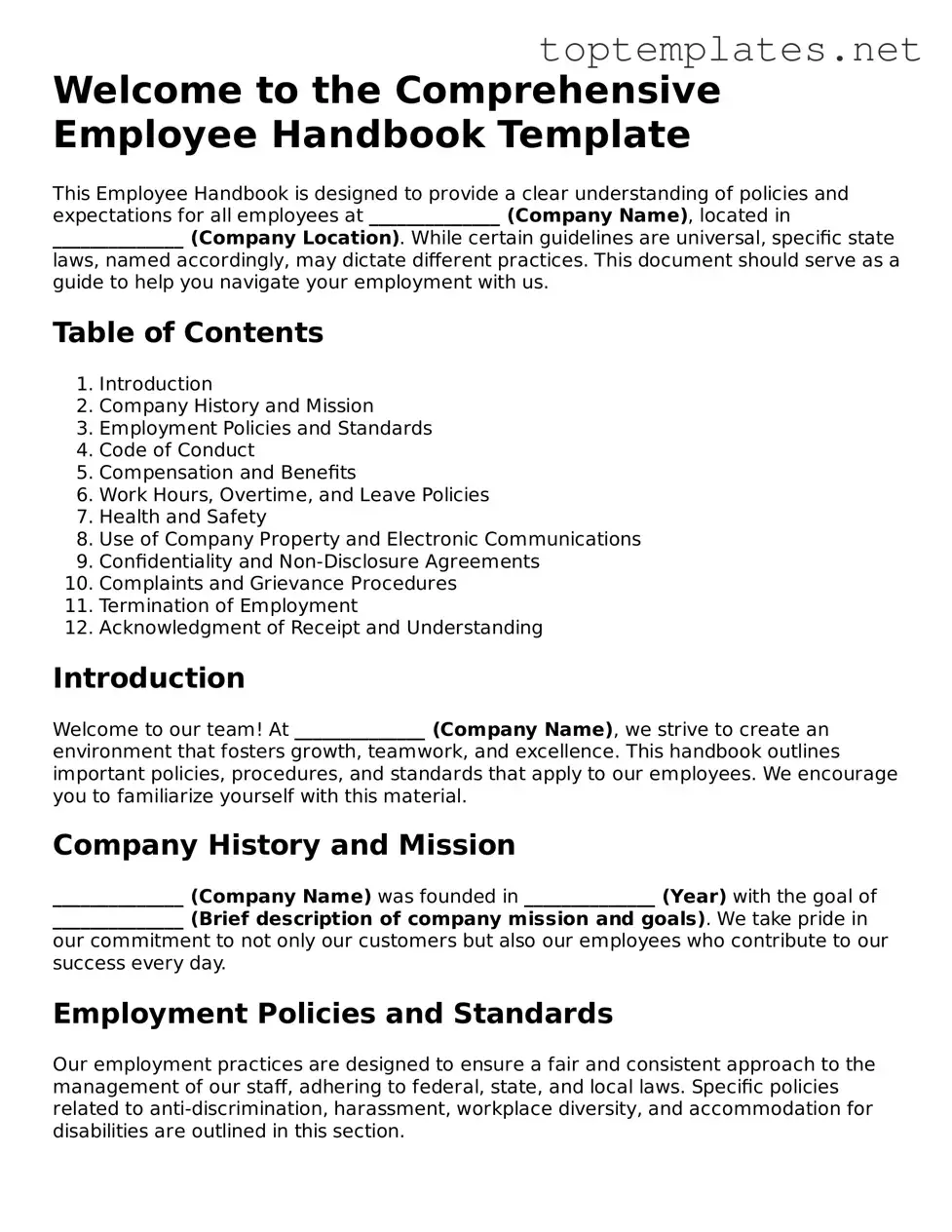Welcome to the Comprehensive Employee Handbook Template
This Employee Handbook is designed to provide a clear understanding of policies and expectations for all employees at ______________ (Company Name), located in ______________ (Company Location). While certain guidelines are universal, specific state laws, named accordingly, may dictate different practices. This document should serve as a guide to help you navigate your employment with us.
Table of Contents
- Introduction
- Company History and Mission
- Employment Policies and Standards
- Code of Conduct
- Compensation and Benefits
- Work Hours, Overtime, and Leave Policies
- Health and Safety
- Use of Company Property and Electronic Communications
- Confidentiality and Non-Disclosure Agreements
- Complaints and Grievance Procedures
- Termination of Employment
- Acknowledgment of Receipt and Understanding
Introduction
Welcome to our team! At ______________ (Company Name), we strive to create an environment that fosters growth, teamwork, and excellence. This handbook outlines important policies, procedures, and standards that apply to our employees. We encourage you to familiarize yourself with this material.
Company History and Mission
______________ (Company Name) was founded in ______________ (Year) with the goal of ______________ (Brief description of company mission and goals). We take pride in our commitment to not only our customers but also our employees who contribute to our success every day.
Employment Policies and Standards
Our employment practices are designed to ensure a fair and consistent approach to the management of our staff, adhering to federal, state, and local laws. Specific policies related to anti-discrimination, harassment, workplace diversity, and accommodation for disabilities are outlined in this section.
Code of Conduct
Every employee is expected to conduct themselves in a professional manner that reflects the company's values and standards. This includes, but is not limited to, behavior, dress code, communication, and ethics. Violations of our code of conduct may result in disciplinary action, up to and including termination of employment.
Compensation and Benefits
Our compensation program is designed to attract, motivate, and retain talented employees who contribute to our company's success. This section details your salary, bonus opportunities, and benefits, including health insurance, retirement plans, and paid time off. Eligibility and enrollment procedures are also covered.
Work Hours, Overtime, and Leave Policies
Standard work hours, procedures for recording time, policies on overtime, and types of leave (including vacation, sick leave, and parental leave) are described here. It is important to understand your responsibilities and rights regarding scheduling and time off.
Health and Safety
Maintaining a safe and healthy work environment is a top priority. This section covers our health and safety policies, including compliance with ______________ (Relevant State’s Occupational Safety and Health Act), and guidelines for reporting injuries or unsafe conditions.
Use of Company Property and Electronic Communications
Company property and electronic communication systems are to be used primarily for business purposes. This section outlines acceptable use, as well as privacy expectations and restrictions.
Confidentiality and Non-Disclosure Agreements
Protecting confidential information is crucial to our business. Employees may be required to sign a confidentiality or non-disclosure agreement, the details of which are found here.
Complaints and Grievance Procedures
If you have a complaint or grievance, it is important to follow the procedures outlined in this section to ensure it is addressed fairly and promptly.
Termination of Employment
This section explains the procedures and policies regarding the termination of employment, including resignation, retirement, and dismissal.
Acknowledgment of Receipt and Understanding
All employees are required to sign an acknowledgment that they have received, read, and understood the contents of this Employee Handbook and agree to comply with the policies and procedures described within.
Note: The policies included in this Employee Handbook are subject to change at the discretion of ______________ (Company Name). Employees will be notified of any significant changes. Remember, this document does not constitute a contract of employment.
